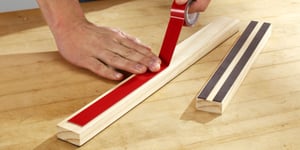Joining two surfaces together doesn’t sound complicated. Yet, depending on the substrates and the performance demanded of an adhesive bond, choosing the wrong adhesive could create a huge mess.
Due to the added benefits, modern materials have started replacing mechanical fasteners and welds. You might be wondering what bonding method to use, which is why we’ve decided to share what we know and our experience using different types of adhesive bonding materials.
Once you’ve learned more about the alternatives, you can decide which bonding solution is right for your future product.
Types of Adhesive Bonding Materials
Adhesives are materials meant to temporarily or permanently hold two or more objects together through surface contact.
Historically, mechanical fasteners— rivets, brackets, bolts, screws, retaining rings — have been used to “permanently” bond two substrates. Unfortunately, mechanical fasteners tend to look unsightly, and their weight and likelihood of corrosion increase the possibility of bond failure.
Rather than using mechanical fasteners, we’ve spent over three decades working with low-profile industrial bonding adhesive alternatives like acrylic foam tapes, which evenly distribute pressure along the substrates.
each material offers specific advantages. For instance, liquid adhesives, like glue or epoxy, can fill gaps by flowing and conforming to the shape of the bond area.Let’s explore the adhesive bonding materials that might suit your project needs. Then, we’ll take a closer look at how to choose a material based on your substrates.
1. GLUE
Glues created relatively weak bonds in the past, yet recent innovations with self-curing adhesives now make glue a preferred material for joining many applications.
Liquid adhesives come in bottles, tubes, and other forms of sealed containers. This adhesive cures when it comes in direct contact with a surface or hardens from the moisture in the air. Liquids fill voids and can be sprayed to cover large-area applications.
Many types of glue are now carbon-based petrochemical derivatives, so bonding metal to dissimilar materials is more effective. The properties of glue allow it to act as an adhesive and sealant simultaneously.
Similar to epoxy, glue application can be tricky. Expensive machinery is often the preferred application method. In addition, glue bonds may fail when the bond is exposed to prolonged heat or weathering
2. ADHESIVE TAPE
Tapes are the most popular form of adhesive. They come in roll form and can be converted into customized sizes, shapes, and forms.
Among adhesive tapes are pressure-sensitive adhesives (PSAs), water-activated, and heat-sensitive tape. Each of these tapes have a wide range of application usage in almost every industry.
When die cut, adhesive tape fits seamlessly into automated or manual assembly processes. In addition, they create secure coverage that can function as a seal.
When a strip of pressure sensitive adhesive tape connects the two substrates along the entire bond, the force on a bond is evenly distributed. Fewer concentrated stress points decrease stress and failure while increasing the shear strength.
One of the most significant advantages of adhesive tape bonding is versatility because it allows you to bind a wide range of dissimilar surfaces and objects.
In addition to increased shear strength, adhesive tape is one of the most aesthetically pleasing bonding options. Adhesive bonding tape creates a tight, low-profile connection without adding unsightly bulk to the components.
Lastly, automatic adhesive dispensing, typically using a robotic system, makes assembly accurate, efficient, and consistent.
3. ADHESIVE FILM
Adhesive films are a thin layer of high-performing bonding agent on a backing material that creates a strong bond.
Films are similar to tapes; they come in roll form and can be converted to custom shapes and sizes. Films are often used as a protective barrier or bonding materials with a smooth, transparent substrate for electronic devices.
While some adhesive films are moisture-activated or heat-activated, films are typically pressure-sensitive adhesives. Adhesive films also contain no liquids, allowing them to be stored longer.
The difference between adhesive film and adhesive tape is that tape tends to have more adhesive and thicker construction. Adhesive tape also tends to have a higher holding power for more structural stability.
Modern bonding innovations have enabled glues and weak adhesive films to transform into durable, trusted materials. Yet, similar to glues, most films now use self-curing adhesives. These bonds are strong yet require extra curing time.
4. HOT MELT
Solid hot melt adhesives are heat-activated adhesives typically used for very specific applications. The adhesive comes in sticks (like hot glue-gun sticks), cartridges, or pellets, making the adhesive very clean and easy to store and handle.
Heat-activated adhesives can function on surfaces where films struggle to function, such as aluminum foil, polyurethane, PVC, and rubber.
5. EPOXY
Generally, epoxies are hard and durable adhesives that successfully bond many substrates.
Epoxies are usually a 2-part system that can be formulated for many applications, cure speeds, and perform in extreme environments. Because of their strength and toughness, epoxies are often used to join structural materials, for instance, plywood.
Unfortunately, epoxies can be challenging to apply, so automated machines are standard yet can also be expensive. During manual application, liquid adhesives are difficult to apply and control. The assembly process must factor in curing, which is often an additional step.
6. PASTE
Pastes come in sealed containers similar to liquid adhesives but are spread along surfaces to form a bond. Adhesive manufacturers have created one-part and two-part paste adhesive formulations for strong bonds to rubbers, metals, wood, plastics, and masonry.
7. SPRAY ADHESIVE
As a contact adhesive (a.k.a. rubber-based), spray adhesives are typically used to bond paper, fabrics, foam, and felt.
Contact adhesives are often used for more demanding projects: metal, plastic sheet laminates, and wood. The downside is that it can be challenging to use spray adhesive to achieve a uniform thickness across the entire surface.
The application of spray adhesive is one of its most difficult facets. It’s essential to apply in a well-ventilated room using a specialized applicator, either manual or automatic. The spray adhesive solvent must completely evaporate before bonding, after which repositioning your substrate will be impossible.
Temporary or Permanent?
Not all adhesive bonding options are permanent, especially low-profile solutions. Think of reclosable packaging, changeable gaskets, and other removable material. Since the goal isn’t always the strongest bond, using tape with reliable holding properties that can be removed or repositioned easily is vital. These are often called “temporary bonding tape,” “removable tape,” or “repositionable tape.”
What Should I Know About Bonding Before Choosing My Materials?
Any bonding material selection aims to help you create your solution while manufacturing products in efficient, effective, and innovative ways.
Adhesive bonding materials offer the following advantages:
- The lack of drilling/holes reduces labor costs
- Thin, light materials reduce weight and energy use
- Stress is distributed evenly across the bond
- It’s easier to bond dissimilar materials
- Seal and bond simultaneously
- Vibration is reduced in the final product
However, certain materials lend themselves to production better than others and offer more versatility for a broader range of applications.
SUBSTRATES ARE CRITICAL TO CHOOSING YOUR ADHESIVE
In our blog series on thin bonding, we explored how a substrates' surface energy affects adhesion. High surface energy offers strong molecular attraction, while low surface energy offers weak attraction.
HIGH SURFACE ENERGY SUBSTRATES
E.g. metal, glass, epoxy paint, PVC rigid, nylon, and polyester.
Strong, durable, cost-effective, and easily machined metals are typically easy to bond if the surface has been prepared appropriately. Bonding metals enhance the advantages of many bonding adhesives: gap-filling and isolation of substrates.
Glass, ceramic, concrete, and natural materials like wood, textiles, leather, and stone are traditional materials with medium surface energies, making them harder to bond than metals but easier than some of the materials below. A converter will help determine the specific adhesive to bond each material.
Engineered plastics, such as polycarbonate, acrylonitrile butadiene styrene (ABS), urethane foam, and many coatings, are strong and stiff plastics. While they perform well at high temperatures and are easy to bond, they cost more than other options.
LOW SURFACE ENERGY SUBSTRATES
E.g. composites, powders and coatings, acetal, polystyrene, polypropylene, PVA, polyethylene, and other plastics.
The adhesive selection process is essential for plastics with low surface energy (LSE): polypropylene, polystyrene, polyethylene, and many powder-coated paints.
When joining low surface energy substrates, you may need help sourcing materials. A flexible material converter could have the right experience and supplier connections to guide you in the right direction.
What Role Do Converters Play in Choosing a Bonding Material?
Trusted materials are always needed, but on their own, they’re inadequate.
If you’re new to the process, you might not know how much of a role adhesive selection and product design play in determining how much you spend on part manufacturing. A full-service converter helps you determine adhesive bonding materials for each product based on design manufacturability.
Preparing for your adhesive design phase can be challenging, but a converter can help you define a strategy and production process to build the most effective parts while avoiding common errors:
If you’re considering an adhesive tape or film, you’ll want to consider reaching out to schedule a consultation so you can get started on an effective adhesive bonding solution.
Suppose you’re new to working with a converter or have doubts about the process. In that case, you can further the search for the right adhesive bonding materials by reading our Flexible Material Converting Q&A Guide, where we’ll answer questions we’ve been asked as flexible material converters.
Originally published: March 22, 20







